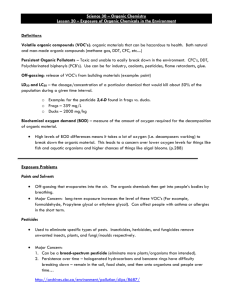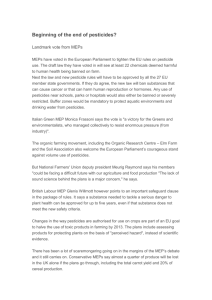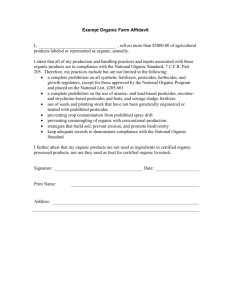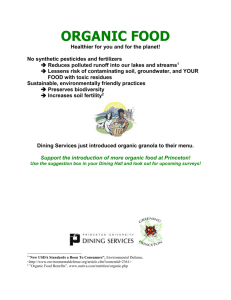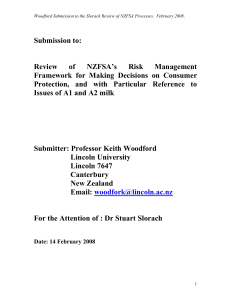Organic Food We may look at all the fat, salt and sugar content on
advertisement
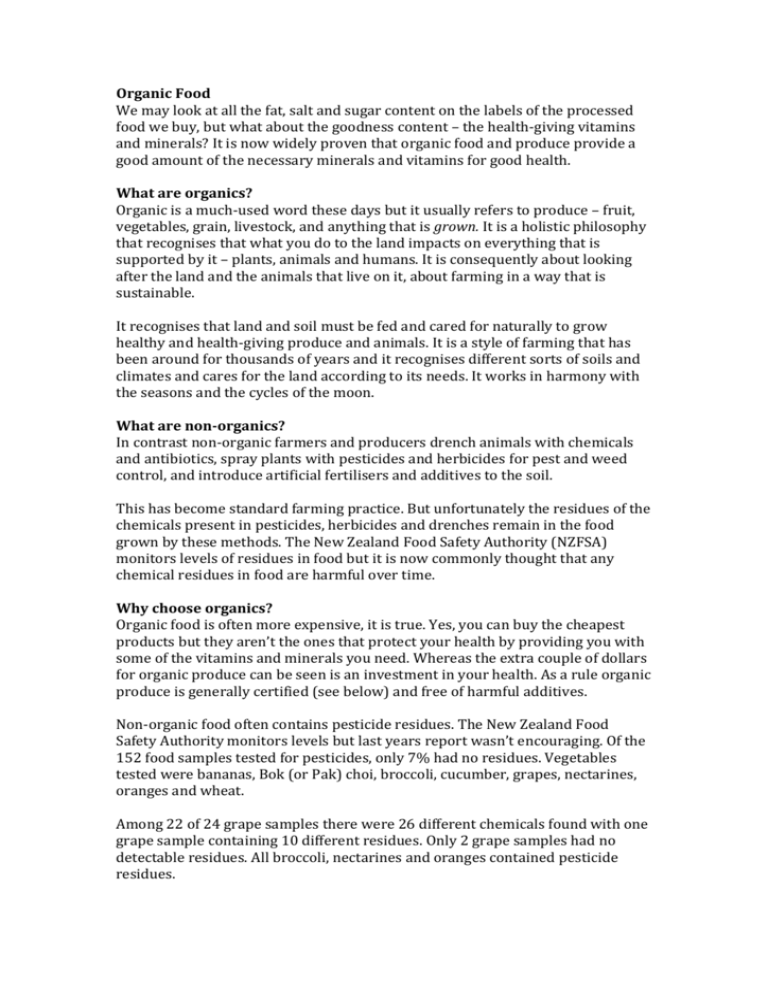
Organic Food We may look at all the fat, salt and sugar content on the labels of the processed food we buy, but what about the goodness content – the health-giving vitamins and minerals? It is now widely proven that organic food and produce provide a good amount of the necessary minerals and vitamins for good health. What are organics? Organic is a much-used word these days but it usually refers to produce – fruit, vegetables, grain, livestock, and anything that is grown. It is a holistic philosophy that recognises that what you do to the land impacts on everything that is supported by it – plants, animals and humans. It is consequently about looking after the land and the animals that live on it, about farming in a way that is sustainable. It recognises that land and soil must be fed and cared for naturally to grow healthy and health-giving produce and animals. It is a style of farming that has been around for thousands of years and it recognises different sorts of soils and climates and cares for the land according to its needs. It works in harmony with the seasons and the cycles of the moon. What are non-organics? In contrast non-organic farmers and producers drench animals with chemicals and antibiotics, spray plants with pesticides and herbicides for pest and weed control, and introduce artificial fertilisers and additives to the soil. This has become standard farming practice. But unfortunately the residues of the chemicals present in pesticides, herbicides and drenches remain in the food grown by these methods. The New Zealand Food Safety Authority (NZFSA) monitors levels of residues in food but it is now commonly thought that any chemical residues in food are harmful over time. Why choose organics? Organic food is often more expensive, it is true. Yes, you can buy the cheapest products but they aren’t the ones that protect your health by providing you with some of the vitamins and minerals you need. Whereas the extra couple of dollars for organic produce can be seen is an investment in your health. As a rule organic produce is generally certified (see below) and free of harmful additives. Non-organic food often contains pesticide residues. The New Zealand Food Safety Authority monitors levels but last years report wasn’t encouraging. Of the 152 food samples tested for pesticides, only 7% had no residues. Vegetables tested were bananas, Bok (or Pak) choi, broccoli, cucumber, grapes, nectarines, oranges and wheat. Among 22 of 24 grape samples there were 26 different chemicals found with one grape sample containing 10 different residues. Only 2 grape samples had no detectable residues. All broccoli, nectarines and oranges contained pesticide residues. New Zealand Soil & Health Association said of the 2010 NZFSA report “Cancers, endocrine disruption, foetal abnormalities, neurological disease and many other conditions have been proven to be associated with pesticides as found in NZFSA residue surveys, yet in the name of trade, NZFSA, Environmental Risk Management Authority (ERMA) and Food Standards Australia New Zealand (FSANZ) continue to allow unnecessary chemical use and residues.” The Dirty Dozen Food in New Zealand with the most pesticide residues ranked according to number of pesticides detected in total samples and percentage with pesticides The foods that contain the most pesticide residues are known as the Dirty Dozen. So what are they? Food % with residues no. of pesticides sample size 1. Celery 98.2 21 56 2. Peaches, fresh/canned 96.4 15 56 3. Apricots, fresh/canned 96.4 14 56 4. Butter/cream/cheese 100.0 3 24 5. Wheat: bread, all products 79.3 23 232 6. Apples 80.5 20 288 7. Plums 91.6 8 48 8. Mandarins 83.3 10 36 9. Raspberries 85.4 7 48 10. Oranges 82.1 9 56 11. Strawberries 71.7 16 92 12. Grapes/raisins/sultanas 57.1 25 28 If you buy organic at least the foods listed here, then you will be significantly reducing the pesticide load on your body. The Clean Fifteen In contrast the Clean Fifteen are a group of foods that aren’t so vulnerable to pesticides because of their thick skins or the way they are grown: onions, sweet corn, pineapple, avocado, asparagus, sweet peas, mango, eggplant, rock melon, kiwifruit, cabbage, watermelon, kumara, grapefruit, and mushrooms. Organic food labelling There is no legislation or rules around labelling something organic. Growers can call produce organise without providing proof. Consequently a number of organisations have been established to certify organic growers. Growers must comply with organic production standards to become fully certified. There are three main certifiers in New Zealand. BioGro is the premier certifier with the strictest standards, but there is also the international certifier Demeter, and Agriquality. Hua Parakore, the Maori organic certifying label also recently arrived in the market. Each of these certifiers has its own distinctive label to look out for. What to look for in food labeling generally? Food labels tend to contain two lists: one with ingredients and the other with nutritional value. Any chemicals tend to be listed in the ingredients list with numbers that have the effect of disguising what they are actually are. And the list for nutritional value tends to focus on salt and fat content. Look for real ingredients like honey, rolled oats, buckwheat, cider vinegar, potatoes. These are known for their nutritional value. Where can you buy organic food? Organic food is everywhere – in the supermarkets, specialist shops, and online. You may have to look a little harder but it is there. Many communities also have organic food co-ops so look out for one in your area. Links http://www.safefood.org.nz/ http://www.thedailygreen.com/healthy-eating/eat-safe/dirty-dozenfoods#ixzz1Y59q9qdm http://www.scoop.co.nz/stories/BU1107/S00030/launching-hua-parakore-anew-maori-indigenous-food-label.htm
